Pinched nerve in the Lower Back
The pinched nerve can be induced in the lower back due to pressure generated on the nerves and tissues near the vertebrae in the lower spine. You may feel a range of symptoms like numbness and sharp pain. This is also known as lumbar radiculopathy. A pinched nerve in your lower back happens when there has more pressure on the nerves near the lumbar vertebra. A pinched nerve can be painful and may slowly affect your overall quality of life.
What Is a Pinched Nerve?
A pinched nerve is exactly the pressure generated by the surrounding tissue and thus, fails some circulation. This stress can be generated by the surrounding muscles, cartilage, or bones, leaning on the place of the pinch. When this stress gets, the neurons inside our nerves fail a bit of their route of conduction, inducing symptoms like numbness, weakness, pain, and tingling.
If you notice ongoing pain in your lower back despite rest, it is important to consult your doctor for a proper diagnosis. A herniated disk, for example, occurs due to disks that provide cushioning between the vertebrae bulging out from the vertebra, compressing on nearby nerves. Another reason is when the canal where nerve fibers pass through the spine becomes small. Injuries, genetic factors, and various medical conditions can induce a pinched nerve. The main symptom of a pinched nerve is sciatic pain, which people mostly call sciatica.
The human spine contains many nerves, it carries signals to the brain. If bones or tissues in the spine compress on a nerve, this misleads the signals. This disruption induces the symptoms of a pinched nerve. In the lower back, a pinched nerve may radiate pain into the pelvis, legs, and feet. This symptom can be noticed instantly after back injury, or gradually, as the result of osteoarthritis and other age-related changes. Know more about the upcoming symptoms and causes of a pinched nerve in your lower back and which treatment suits you. The doctor may recommend both short-term and long-term relief.
Anatomy of the lumbar spine:
Each spinal nerve has two branches the right and left sides of the spinal cord or the cauda equina. The spinal nerves are made up of two types of fibers the sensory fibers and the motor fiber. sensory fiber that will transmit messages to the brain and motor fibers that collect messages from the brain.
Five pairs of lumbar spinal nerves gradually increase in size from L1 to L5. These nerves leave the intervertebral foramina below the interconnected vertebra. For sample, the L4 nerve leaves under the L4 vertebra through the L4-L5 foramen. These nerves run down from the lower back and connect with other nerves to form the lumbar and lumbosacral plexuses (a network of nerves), which innervate the lower limbs.
Nerve Root and Spinal Nerve:
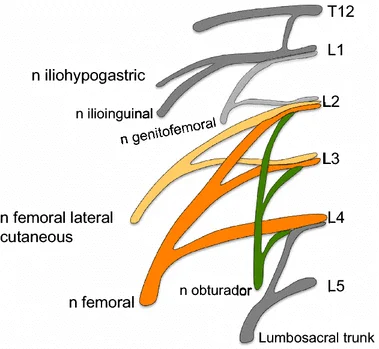
The format of a spinal nerve, as it exits the spinal cord or cauda equina, contains:
- Nerve root: Region of the nerve that radiates off the spinal cord or cauda equina. At every level, a pair of nerve roots arise from the right and left sides of the spinal cord. The pair of nerves consists of two sites a dorsal root at the rear and a ventral root at the front.
- Spinal nerve: A spinal nerve is made up of two nerve roots the dorsal and ventral nerve, These two root joins and originate from the spinal nerve, this process generally occurs inside the intervertebral foramen. The spinal nerve travels a brief distance inside the intervertebral foramen, after which it diverges off into different nerves that originate at other parts of the body.
Dermatomes and Myotomes:
The spinal nerves are supplied to the skin and the muscles of a specific region.
- A dermatome is a clear area of skin that is supplied by the dorsal root fibers of a spinal nerve. The dorsal root fibers have sensory information from the dermatome to the brain.
- A myotome is a group of muscles directed by the ventral root fibers of a spinal nerve. The ventral root fibers have motor signals from the brain to the myotome.
If a spinal nerve gets uncomfortable or compressed, sensory and/or motor deficits may occur in the related dermatome and myotome.
Functions of the Lumbar Spinal Nerves
The five pairs of lumbar spinal nerves supply the lower limbs. While innervation can vary among everyone, some common ways include :
- The L1 spinal nerve gives sensation to the genital and groin area and may also supply to the hip muscles.
- L2, L3, and L4 spinal nerves supply feeling to the anterior part of the thigh and the inner side of the lower leg. These nerves also manipulate the actions of the hip and knee muscles.
- L5 spinal nerve transmits feel to the web space between the foremost and second toe and the lateral side of the lower leg, the upper area of the foot.
- The L5 spinal nerve contains hip, knee, foot, and toe activities.
The L4 and L5 nerves made a large sciatic nerve that supervises down from the back pelvis into the rear of the leg and ends in the foot. Symptoms and signs appearing from these nerves typically referred to as sciatica, can cause a sharp, burning pain releasing down the leg with associated feebleness and numbness. The lumbar spine is growing slowly so, so this anatomy, in addition, to lower back conditions, such as disc herniation or degeneration may generate the nerve to get packed, resulting in leg pain and weakness.
Causes of a pinched nerve in the lower back:
This will occur as a result of a trauma, such as a downfall. You are more likely to feel this symptom if you are between ages 35 and 50. This is due to your vertebrae pressing with age, and the discs in your vertebrae degenerate over time. Another main cause of a pinched nerve in the lower back is a herniated disc. You may notice this condition because of aging, a defect in your vertebrae, or wear and tear. Men age 25 to 54 are at a high risk of developing a herniated disc.
Different reasons for a pinched nerve in the lower back:
- Bulging disc
- Spinal stenosis: In this spinal canal can be narrow.
- Bone spur formation (osteophytes)
- Spondylolisthesis: In this vertebra slip from its original position.
- Foraminal stenosis
- Degeneration
- Rheumatoid arthritis
- Trauma or inflammation will put pressure on the nerves
- A herniated disk, in this disk between two vertebrae becomes compact or protrudes out.
- An infection: Infection occurs due to some other reason like metastatic disease in the spinal disks, joints, or bones
- osteoporosis
Specific risk factors that will more likely develop nerve pain or a pinched nerve in the lower back.
These factors include:
- Obesity
- Aging
- Low levels of physical activity
- Altered posture
- Older age and a sedentary lifestyle may decrease the muscle power around the spine and make persons more likely to happen age-related conditions, such as spinal stenosis.
- Being overweight and altered posture put more pressure on the vertebra, increasing the chance of a nerve canal becoming narrowed.
Symptoms of Pinched nerve in the lower back:
You may feel different symptoms with a pinched nerve in your lower back like sharp pain and numbness. The pains may feel sometimes comes and go, creating stabbing sensations.
Additionally, you may also experience:
- weakness
- Muscle spasms
- Reflex loss
- Numbness
- Sharp pain in the lower back
- Back to the feet pain is radiating
- The different sensations feel in the lower limb and back like numbness, burning, or tingling.
The sciatic nerve in the lower back can be mostly compressed due to the above reasons and it is known as sciatica.
Sciatica
Sciatica describes symptoms that relate to problems with the sciatic nerve that originate from your lower back to feel. If the sciatic nerve is injured or compressed, you may feel sciatica symptoms.
Sciatica symptoms can feel like a sharp pain, tingling, numbness, and muscle weakness that may happen in the described areas:
- Lower back
- Pelvis
- Glute region
- Legs
- Ankles and feet
Symptoms of sciatica tend to worsen when you make jerky movements, like sneezing. The pain may also be significant enough to interfere with daily activities, such as walking. Additionally, you may feel tingling sensations between your lower back and ankles that feel like “pins and needles.”As a rule of thumb, if your pain only feels in the lower back, so there has no sciatica.
Muscle or nerve pain?
Nerve pain feeling is different from back pain. This pain can be sharp. It feels sensations of burning, tingling, and numbness. muscular pain typically induces muscles and joints to feel stiff, spasm, or tender.
If a person suffers only from lower back pain that does not affect their legs or feet or does not feel a sensation like numbness, tingling, or burning sensations, it can be a different type of condition.
When to see a doctor?
If you feel low back pain for a long time then ought to be checked by a doctor, especially if your pain compromised your daily activities. when your medic properly analyzes a pinched nerve and its causality, your physician can then refer you to treatments that can assist. If you are recently undergoing treatment for a pinched nerve in your lower back, it is also important to see your doctor if symptoms worsen or do not relieve within 4 to 6 weeks.
Investigations:
From your symptoms and pain, the doctor advises you to do some diagnostic tests to rule out the diagnosis. It is important to provide as many details as you suffer, such as how long you have been noting pain and discomfort, how it was affecting your rate of life, and whether you have just undergone any current damages.
your doctor will see for physical signs of injury or other issues in your low back by checking for possible:
- Limited range of movement
- Balance issues
- Changes to reflexes in your lower limb
- Weakness in lower limb muscles
- Changes in sensation in the lower limb
If Your doctor may not be able to rule out the diagnosis from a physical examination alone. Then advise doing some tests.
- X-ray: X-rays show the bony cartilage in your vertebrae which is in a normal place or displaced.
- MRI: It shows your soft tissues like the discs in your vertebrae, your spinal cord, and the nerves in your lower back.
- CT scan: It shows a very detailed picture of your lower spine and can be used to evaluate vertebral structures and muscles.
Such diagnostic tests are typically advised in the case of prolonged symptoms only.
Treatment for the pinched nerve in the lower back:
Once the diagnosis of the pinched nerve in your lower back is confirmed by the doctor, you can start to consider treatment. Treatment may include a combination of:
- Over-the-counter (OTC) pain relievers
- Physiotherapy
- Other lifestyle changes
Sometimes your doctor will need to apply invasive measures, such as spinal injections or surgery for more symptoms.
Baseline treatments
Your doctor will advise initially noninvasive, baseline treatments for your pinched nerve for several weeks. In many cases, nonsurgical treatment will help to relieve your symptoms.
Medications
If your doctor gives you the go-ahead, you may try Over-The-Counter irritant nonsteroidal anti-inflammatory drugs (NSAIDs) to manage the pinched nerve symptoms. These types of medicines can decrease inflammation and minimize pain. The physician may also advise oral steroids to treat the condition if NSAIDs and other treatments are sufficient.
Physical therapy
Physical therapy can help you to relieve the symptoms caused by a pinched nerve. Your physical therapist will describe some stretches and exercises that will maintain your spine in its alignment.
Home-based remedies
The doctor may advise some lifestyle changes to relieve pain. Some of these treatments may reduce the pain.
- Activity modification. You can feel that many seating positions or activities induce pain like a twist or lift and it makes your pinched nerve worse. The doctor advises you to avoid these activities for some time to reduce this symptom.
- Ice and heat. Applying ice or heat therapy over the pain area for 15-20 minutes 2 times a day may decrease pain and muscle spasms. If you have recently felt a low back injury, however, avoid applying heat therapy for 48 hours.
- Frequent movement. Exercise regularly can help you to avoid the onset of nerve pain or relieve its symptoms. You can also try mild yoga or tai chi as forms of light exercise that still help you to build strength and flexibility.
- Sleeping position modifications. Your sleeping position may initiate the symptoms of your nerve pain. Get to know the best sleeping position for the pain with your doctor and determine how to practice proper sleeping habits. This can adjust your sleeping position or sleep with a pillow between two legs.
Advanced treatments
When the basic treatments do not help to relieve your symptoms then, your doctor may advise more advanced treatment.
Injectable steroids
Your physician may recommend an injectable steroid if your symptoms do not relieve or decrease. You can reduce severe pain by receiving an epidural injection of steroids in a hospital or under fluoroscopy in an X-ray department. This can help to minimize swelling and other symptoms in the affected area.
Surgery
If pain is not reduced by the above treatment then surgery is the last option for treating a pinched nerve in your lower back. There have many surgical techniques, and your doctor will recommend a technique that will target the cause of the condition. For illustration, a herniated disc in your lower back may be treated with a microdiscectomy. This process involves a small incision in your back. Keep in brain that surgeries always come with some risks and sometimes it gets a long recovery time, so you will want to try less invasive methods before going for surgery.
Physiotherapy Treatment in Pinched nerve in the lower back:
Firstly you have to correlate patient symptoms with some special test and by confirming the diagnosis you can start the exercises.
Clinical test for a pinched nerve in the lower back:
- Straight leg raise (SLR) test. This examination holds the patient fibbing on his/her back and lifting one leg at a moment with the other leg flat or bent at the knee. A pain experienced while lifting the affected leg usually suggests sciatica.
- Slump test. This test contains the patient seated vertically with hands after the back. The patient flexes (slumps) forward at the hip. The neck is flexed down with the chin connecting the chest and one knee is extended to the degree possible. If pain arises in this position, sciatica may be present.
Here we explain some exercises and stretches for a pinched nerve in the back:
Always discuss with your doctor before starting any stretches and exercises. You want to make sure you do not worsen your symptoms or do anything that induces more pain.
Goal of Physiotherapy
The goal of physical therapy is dependent on the extent of the injury. When immediate trauma occurs, the goal is for conservative and not extend the existing injury. Once the inflammation has reduced, a step-wise approach to care is started. After thorough a spinal examination therapy is advised to:
- Improve back strength
- Increase back muscles flexibility
- Posture in its alignment
- Decrease clinical symptoms of pain, tingling, and numbness
Take a yoga mat, towel, or carpet to lie on when doing these stretches and exercises. You should do 3 to 4 repetitions of these stretches each time, and make sure to take a deep breath in while stretching.
Knees to chest

- To perform a knee to the chest you have to take a supine lying position on the ground or a met. Flexed your both knees and point them up toward the sky.
- Place your feet on the floor.
- Take your knees up to your chest and hold them there for 15 to 20 seconds. Release your knees and return your feet to the ground in the knees-flexed position.
Mobilizing stretch
- To perform this stretch, take a supine lying position.
- Flexed your both knees and point them up toward the sky
- Now, extend your leg so your foot points up do not point your toe.
- Hold it in the air for 10 to 20 seconds and then release the hold.
- Do this with the other leg.

Gluteal stretch
- Gluteal stretch also starts in the same position with head support and knees pointed to the ceiling. Move one of your legs up and rest your foot on your other flexed leg.
- The raised leg knee will be vertical to your body. Grab the thigh by hand that is keeping up your foot and drag it toward your chest and head.
- Hold the position for 25 to 30 seconds and release. Do this on the other side of the body.
Cat-cow pose
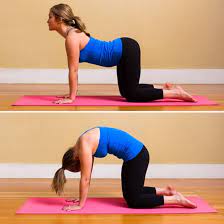
- Begin this exercise with come on all four limbs with the hands and knees shoulder-width apart.
- Arch the back upward like a camel hump and hold the position for two seconds before lowering the back.
- Now into the lower position back make a concave position like a cow then hold it there for 2 seconds. Do it 10–12 times.
Tail wag
- To do tail wag come on all four limbs, the spine should be straight, and then flexed to one side, move the hips toward the ribs. Hold the flexed for 2 seconds, and then repeat the exercise on the next side.
- Repeat the whole exercise 10–2 times.
Lumbar rotation
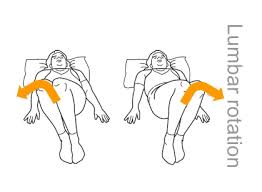
- To do lumbar rotation you have to lie down on the back with the knees flexed and the feet flat on the ground, slowly rock the knees from side to side, allowing the back to rotate slightly.
- Do it 10– 20 times. when you are comfortable, then this helps to stretch the piriformis muscle. Do it on the opposite side.
Sitting spinal stretch
- To perform this stretch you have to Sit upright in a stable chair with your feet shoulder-width apart and knees flexed at a ninety-degree angle and weight distributed evenly.
- Elevate both arms up and stretch up as if you are trying to touch it and hold it. Do this stretch 3 times and try to reach further.
Sitting hip stretch
- To do this stretch you have to sit erect in a sturdy chair with your feet shoulder-width apart and knees flexed at a ninety-degree angle.
- Elevate the right leg and place the ankle on top of the left knee, carefully lean your trunk forward to feel the stretch in the hip area, and hold. do it on the opposite side.
Sitting spinal twist
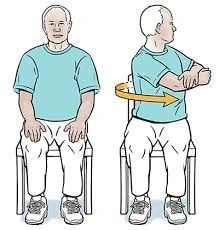
- To do this stretch you can sit on the ground with your back straight and legs extended.
- Flexed left knee and place that foot on the ground on the outside of the right knee.
- Maintain that position, slowly start to turn your trunk towards the flexed knee, and place the opposite elbow on the outside of the flexed knee to get a deeper stretch. You can put your other arm on the ground for support. do it on the opposite side.
Standing hamstring stretch
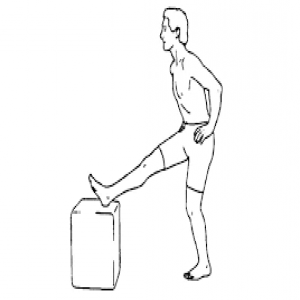
- To do this stretch, you will require a small ledge or stool. Stand up straight with your feet closed.
- Take your right leg out in front of you and rest your heel on the ledge, assembling sure to keep your leg extended but knee soft. your back should be straight and your supporting leg is stable, flexed from the trunk towards the extended leg until you feel the stretch in the back of the thigh and back leg.
- Now hold at this point for 30 seconds 3 times. Repeat on the opposite side.
Slump Stretch
- To perform it sit straight in a chair with your back supported against the post of the chair.
- Raise your right leg straight out so that your toes are faced toward the face while keeping the left foot flat on the ground.
- At the same time move your right ankle towards you while also lowering your head towards it.
- While lowering your head, allow your upper back to come off the chair and flexed your upper body downwards to create a forward-slumping position. Hold the previous position for at least 20 seconds.
- Then, return to the sitting position with good posture and repeat the steps with the left leg. Do this stretch 5-8 times with both legs.
Lunging Hamstring Stretch
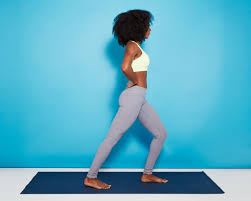
- To perform this stretch you have to stand straight and then take a step forward with your left leg while leaving the right leg in place. by keeping your feet flat on the ground, gently lower your body down so that the knee of the left leg begins to flex.
- Continue to lower yourself until the left leg’s thigh is parallel to the ground.
- The ankle of the left leg should still be vertical with the foot planted firmly on the ground. Place both of your hands on the ground in front of you and extend your body backward slowly until you feel a stretch in the back thigh.
- Hold this position for thirty seconds. Return your body to starting position, then repeat this on another side and do three repetitions on each side.

Seated Hamstring Stretch
- To perform this stretch you have to sit in a chair with both feet flat on the ground and knees flexed.
- Move one leg outer and raise the toes on that side upwards. Bend towards your leg while holding your spine straight and try to grasp your knee. While holding your knee, hold this position for 15-20 seconds.
- Go slow to the seated position until you are sitting vertically likewise. Do these steps with the other leg with five repetitions for both legs.
Back Extension
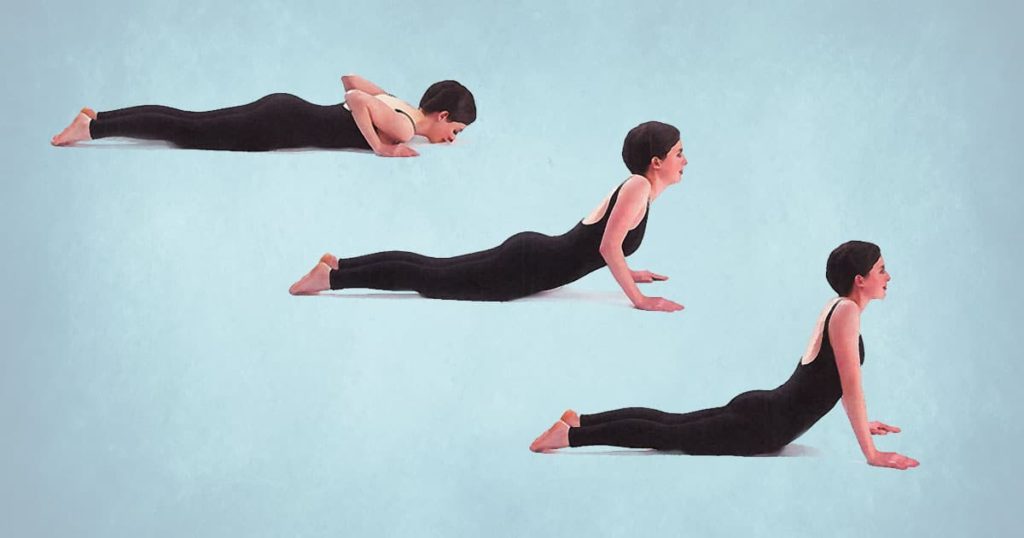
- To perform this exercise you have to lie flat on the ground on your tummy.
- Your hands and forearms should be pressed against the ground and your elbows flexed as if you are about to push the ground away from you. Your neck should be straight and begin to arch your back upwards so that your upper body lifts off the floor.
- Your hips and legs should stay flat on the bottom while accomplishing this. Keep this position for 15 seconds and then back to your actual position. Repeat this exercise 7 times.
Pelvic Tilt
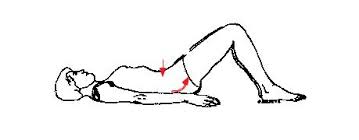
- To perform this exercise you have to Lie down on the ground on your back and flex your knees up while your feet are placed flat on the ground.
- Breathe out slowly and gently push your tummy down using your abdominal muscles so that your back becomes more flattened. Relax your muscles and Do it ten more times.
Seated Figure four

- To do this exercise you have to take a sitting position and cross the right leg over the left leg so that the knee of the crossed leg is flexed while confronting outwards and out from the different leg. This is called the four-figure seated position.
- Your spine should be straight, place your hands over the flexed knee of the crossed leg and gently lean your upper body towards the elevated knee. This can be done very slowly and you should not flex your back or spine when leaning forward. from hip joints most of the movement is taking place which allows your upper trunk to move forward.
- Hold this position for 16 -20 seconds and then return to the straight position. Do these steps with the opposite side by crossing the other leg now. Do it on both sides 4-5 times.
Simple Leg Extensions
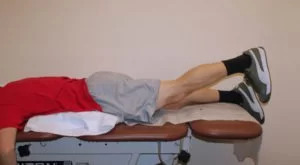

- To do this extension Place your body on all four limbs while looking forward instead of down. breath out by contracting your abdominal muscles. This will help extend your back. raise your right leg outward and upward as you extend it behind your body. Hold this position for 7-10 seconds. Return to the normal position on all fours and then do these steps with the opposite leg.
Child’s Pose
- Position yourself on all fours and lean back so that your buttock is resting just above your feet behind you. Place your arms forward and in front of you with your hands flat on the ground. move your head down so that it is touching the ground. Hold this pose for ten seconds.
- Release the stretch by moving your hands up towards you and lifting both your head and upper body.
- Repeat this pose up to 10 times.
Lying Outer Hip Stretch
- To do this exercise begin by lying flat on the ground on your back.
- Rest your right leg flat without holding it too stiffly in position. Straight but relaxed is ideal. Raise the left leg over the first leg by bending the knee and crossing over it.
- Shoulders should be touching the ground still while doing this and gentle pressure can be applied to the flexed knee by slightly pushing down it.
- Keep this position and then accomplish it with the opposing leg. This stretch can be done with both legs up to five times.
Which exercises you should avoid if you have a pinched nerve?
Before starting a new exercise please consult your doctor or physiotherapist first, then carrying out any stretches be sure to stop instantly if the pain worsens. Only hold the stretches for a long time that is comfortable for you and all exercises can be adapted to be done in a chair or on the ground only.
Try to avoid exercises that may involve:
1. Bending over
2. Elevate both legs
3. Swinging exercise
Bending over
Any activity that facilitates you to stretch bending over will be beneficial if done perfectly. but if a poor form is adopted like a rounding of the torso to pick up things or touch the bottom. The extra stress will be put in the back area and stress the lower back nerve or increased the risk of a herniated disk.
Lifting both legs
An exercise that requires the movement of lifting both legs will encourage you to tighten your core. This is great for supporting your abdominal muscles and lower back but can also exacerbate the pinched nerve symptoms.
Swinging
Activities that involve you pivoting your legs will need a fast reaction from your hamstring and may upset the sciatic nerve. These movements may appear in some Yoga and Pilates routines.
Modality:
TENS
Here are a pair of different ideas on how the TENS unit for sciatica works. The first is that the electrical current interrupts or fully stops the nerve signals that show pain in the brain. Another view is that the nerve stimulation caused by the TENS unit helps the brain to build more endorphins, which then overrides the sensation of pain. Depending on the level of pain, patients may use their TENS unit for as little as one thirty-minute per session. Others may require to utilize this therapy for several hours a day. This is an easily customized treatment that has almost no side effects. The Side effects of this therapy are may include skin irritation if electrodes remain in the same place for more days. Patients with pre-existing heart disease, like to wear a pacemaker for such conditions, and pregnant women should talk with their consultant before starting this therapy.
Ultrasound
The waves created by an ultrasound machine can reduce the time it takes to heal and reduce stiff and stiff muscles by improving circulation and gently warming the muscles.
Intermittent lumbar traction
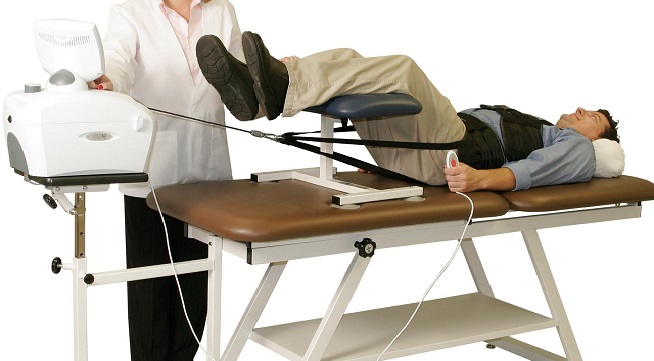
Many theories have been proposed to describe the possible clinical use of lumbar traction for chronic low Back pain. The axial distraction of the stirring point is allowed to change the position of the intervertebral disc relative to the posterior annulus fibrosus or change the slice-whim-whams interface, this can decrease mechanical force wielded on a nerve by a slipped disc. It is even possible that some forms of traction facilitate disc or joint repair, whereas others encourage tissue degradation. Traction is indicated for Low back pain with or without neurologic involvement. A diagnostic test may be needed before assisting traction therapy for CLBP to ban disease states such as severe osteoporosis or if signs or symptoms of a neurologic center are present.
how to use it?
- Put the Lumbar Traction device in its case on a tight shell or bed with the whirls facing up.
- Drag the wheels and unzip the case. Open the case lid toward the head of the bed or therapy surface.
- Release the hand pump from the mesh hold compartment.
- Put the hand pump next to the device.
- Spread the buckles on each of the reins.
- Place the lower harness so it is slightly overlying the upper harness.
- Have a timepiece, timekeeper, or wristwatch available to check the time of your treatment.
Here are some tips for a pinched nerve
- Avoid harsh activities temporarily.
- Apply hot or cold packs over the pain area, it helps to ease on pain.
- Take non-steroidal anti-inflammatory drugs (NSAIDs), like ibuprofen (Advil), to decrease pain and swelling.
- Take prescribed muscle relaxants drugs to relax tight muscles.
- Apply counter irritants over the pain area like capsaicin and lidocaine.
- Altered posture due to computer work can be managed by ergonomics.
- Use proper lifting techniques to minimize stress on the back.
- Avoid repetitive movements.
- Maintain your weight.
- Avoid smoking
FAQ
How I can fix a pinched nerve in my lower back?
The most advisable treatment for a pinched nerve is to give rest to the affected area. Your physician may advise you to stop any activities that induce the compression. Depending on the affected part of the back, you may instruct a splint, collar, or prop to immobilize the affected region.
How much time is taken to treat a pinched nerve in the lower back?
From stabilization and other conservative therapy, most patients heal from the pain within rare days or weeks. Sometimes, operative treatment is needed to reduce pain from a pinched nerve.
Why can pinched nerves occur?
While age or bad posture can play an important role in soreness, a pinched nerve may be responsible. When the most direct tissues push down on one or more nerves, the condensation of muscles, tendons, bones, or cartilage can exacerbate pain, numbness, weakness, or tingling.
Which things you should avoid with a pinched nerve in the back?
When treating a pinched nerve, it is likewise important not to overuse the damaged nerve. It can be made worse by overuse. A patient with pain should avoid any activities that aggravate the nerve. the patient should also try to sleep in a position that decreases the pressure on the affected area.
Is operative treatment needed for a pinched nerve?
Surgery for a pinched nerve can be advisable if the pain is not relieved by the conservative method. Severe pain, maintained numbness, or substantial weakness may be signed for surgical intervention. The impulsive onset of imperfection such as a foot drop should caution the patient to pursue immediate neurosurgical consultation.
Is walking fine for a pinched nerve in the lower back?
After doing light stretching, consider low-impact exercises like walking, cycling, and swimming. These exercises will improve blood circulation to the destroyed nerve, promoting healing and easing the pain associated with a pinched nerve.
Which is the most useful home remedy for pinched nerve patients?
A person with a pinched nerve can use ice therapy or may also use hot therapy. Heat therapy may help to improve blood circulation and loosen the muscles enveloping the pinched nerve. Apply a heating pad to the affected area for twenty minutes at one time, many times a day.
What position is most suitable for a pinched nerve?
The side-lying position is can the most relaxed position for pinched nerve patients.
Which is the best exercise for nerve damage?
Go a Walking. Aim to walk 30 minutes a day 5 days a week with 20 minutes prior.
Low-Impact Exercises for back muscles.
Gradually start resistance Exercise.
Stretching Boosts Flexibility.

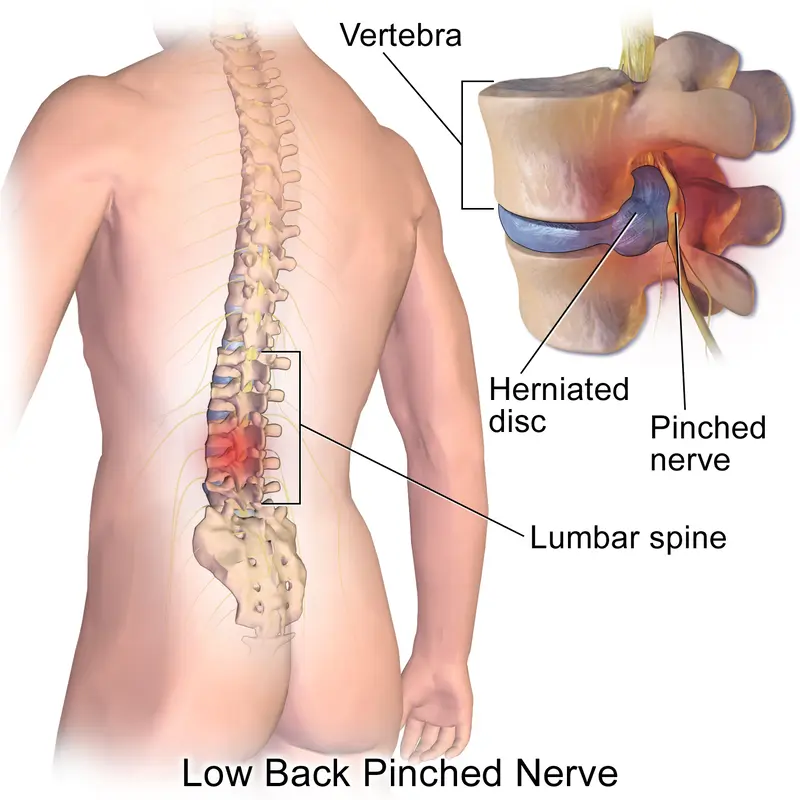
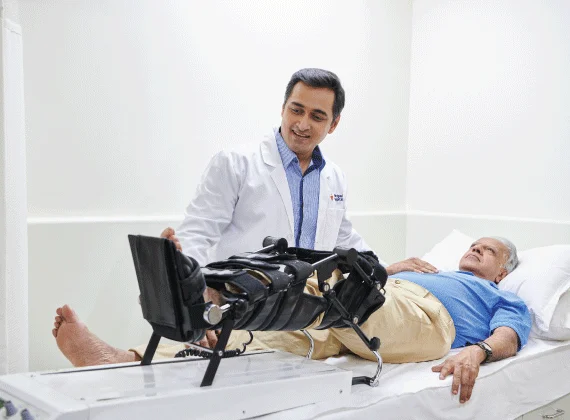
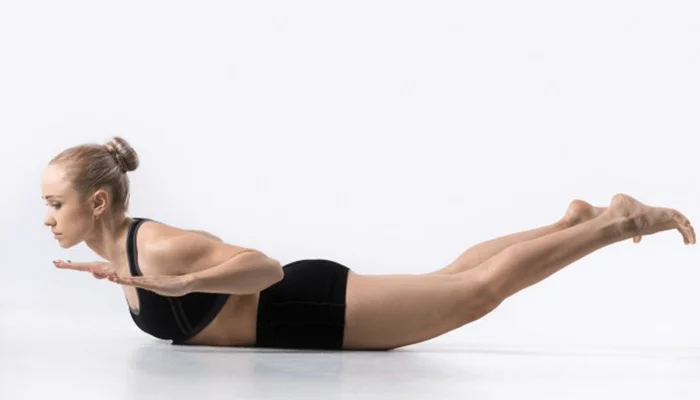

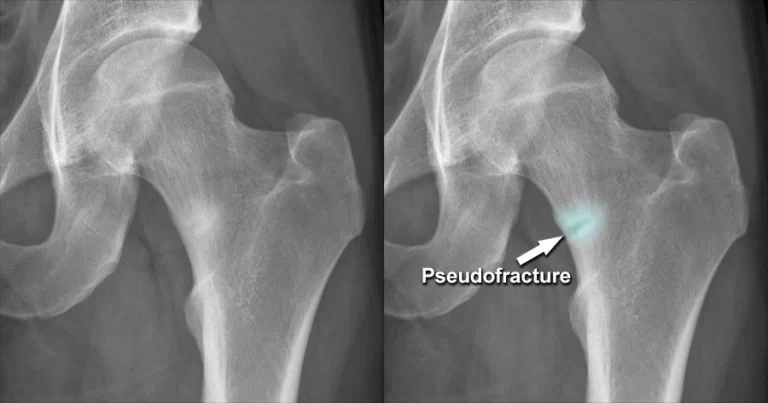
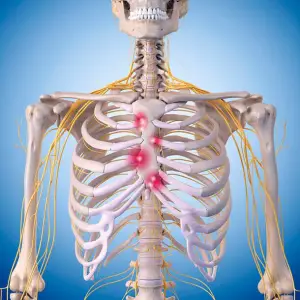
3 Comments